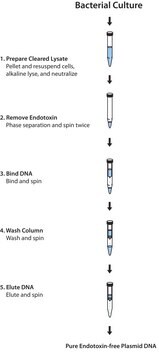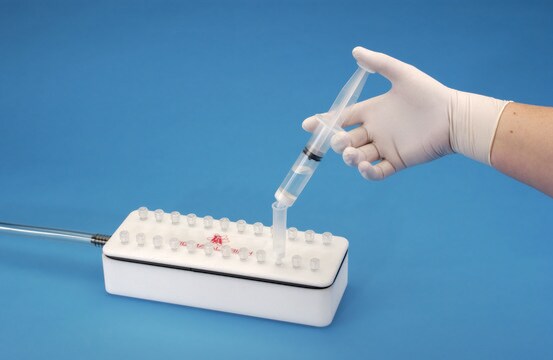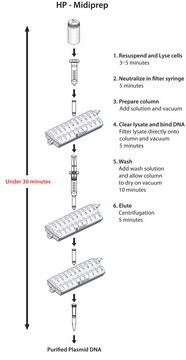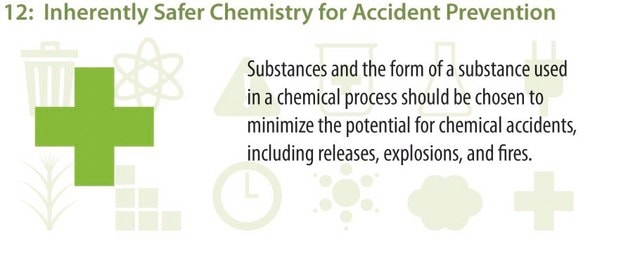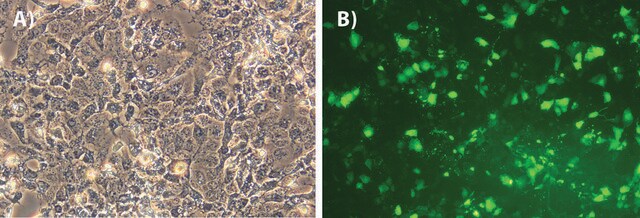Kluczowe dokumenty
HPPIKRO
Roche
High Pure Plasmid Isolation Kit
Roche, pkg of 50 purifications (11754777001), pkg of 250 purifications (11754785001)
About This Item
Polecane produkty
producent / nazwa handlowa
Roche
Poziom jakości
opakowanie
pkg of 250 purifications (11754785001)
pkg of 50 purifications (11754777001)
Opis ogólny
The High Pure Plasmid Isolation Kit isolates purified plasmid DNA in small quantities using the alkaline lysis method, a commonly used method that generates highly purified plasmid DNA from E. coli, free of RNA contamination.
Capacity: The High Pure Spin Filter Tubes hold up to 700 μL sample volume.
Sample: 0.5 - 4.0 mL cultures of E. coli (harvested at a density of 1.5 - 5.0 A 600 units/mL)
Zastosowanie
- PCR
- Sequencing
- Cloning
- In vitro transcription
- Restriction enzyme digests
- Random primed labeling
Cechy i korzyści
- Quickly purify up to 24 plasmid samples in <30 minutes.
- Minimize DNA loss with a kit that removes contaminants without precipitation or other handling steps that degrade DNA.
- Improve reliability and reproducibility in downstream applications with a kit that removes RNA and other impurities that cause plasmid DNA to behave unpredictably.
- Eliminate the use of hazardous organic compounds such as cesium chloride, phenol, chloroform, and ethidium bromide.
Komponenty
- Suspension Buffer
- RNase A, dry powder
- Lysis Buffer
- Binding Buffer
- Wash Buffer I
- Wash Buffer II
- Elution Buffer
- High Pure Spin Filter Tubes (containing glass fiber fleece)
- Collection Tubes
Jakość
Uwaga dotycząca przygotowania
Inne uwagi
Hasło ostrzegawcze
Danger
Zwroty wskazujące rodzaj zagrożenia
Zwroty wskazujące środki ostrożności
Klasyfikacja zagrożeń
Acute Tox. 4 Inhalation - Acute Tox. 4 Oral - Eye Dam. 1 - Skin Corr. 1
Kod klasy składowania
8B - Non-combustible, corrosive hazardous materials
Klasa zagrożenia wodnego (WGK)
WGK 1
Temperatura zapłonu (°F)
Not applicable
Temperatura zapłonu (°C)
Not applicable
Wybierz jedną z najnowszych wersji:
Certyfikaty analizy (CoA)
It looks like we've run into a problem, but you can still download Certificates of Analysis from our Dokumenty section.
Proszę o kontakt, jeśli potrzebna jest pomoc Obsługa Klienta
Masz już ten produkt?
Dokumenty związane z niedawno zakupionymi produktami zostały zamieszczone w Bibliotece dokumentów.
sequencing of laryngeal Leishmania infantum infectionv
Nasz zespół naukowców ma doświadczenie we wszystkich obszarach badań, w tym w naukach przyrodniczych, materiałoznawstwie, syntezie chemicznej, chromatografii, analityce i wielu innych dziedzinach.
Skontaktuj się z zespołem ds. pomocy technicznej

